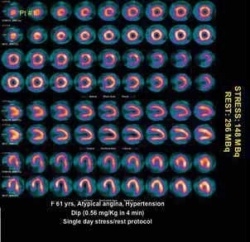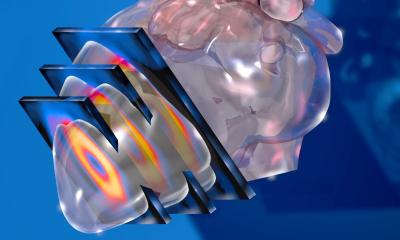Alcyone Technology
Cardiologist, nuclear medicine specialist and researcher Dr Alessia Gimelli works for the Fondazione Toscana Gabriele Monasterio, National Research Council in Pisa, Italy. For the past year she has used Discovery NM 530c, GE’s latest Nuclear Cardiology platform, featuring an innovative CZT collimation technology called Alcyone Technology.

This system not only improves dose management but also performs a complete functional and anatomical cardiac assessment in less than five minutes. During ESC 2010, Daniela Zimmermann asked Dr Gimelli about this and other cardiac assessment methods.
The new Discovery NM 530c system is not Single Photon Emission Computed Tomography (SPECT). It is, explained Dr Gimelli, a completely new type of camera using a gamma photon tracer. Whilst a standard camera needs a lot of tracer to perform myocardial perfusion imaging, Alcyone’s totally new collimator design allows for lower tracer dose, yet the acquisition is the same. ‘This is very important because one of the major problems of standard SPECT in nuclear medicine is the high dose that must be given to a patient to see something. While you perform the same SPECT, with Alcyone you can use a very low dose, -- for instance, for a standard dose you use 11 mSV while for Alcyone you can use as little as 5 mSV (Figure 1).’
In standard SPECT, a patient receives the tracer, the camera performs a series of images and then all the images are reconstructed, Dr Gimelli pointed out. ‘With Alcyone, the camera is in a fixed position and all the collimators are focused around the heart. At the end, a 3-D reconstruction of the left ventricle can be performed. Standard SPECT acquires 32 different images for 180 degrees and at the end you can perform a 3-D reconstruction with a back-projection. In terms of efficiency, the technology used for standard camera produces among 3000 charges every detected electron, due to the photo-multipliers. With this new technology, the new type of cadmium zinc telluride (CZT) collimation, the number of charges produced for every detected electron is among 31,000. This type of collimation is the same as is in an airplane’s black box. The applications of this new type of material are incredible. You can use this material for different kind of jobs and have different types of results’.
‘We have had Alcyone for a year now, so have studied many patients. In the first study we compared standard SPECT and Alcyone technology – obviously in the same patient. Alcyone technology shows a better sensitivity in the detection of coronary artery disease especially in patients with 2 and 3 vessel disease (Figure 2). In particular, we found that the Alcyone could detect ischemia in all the vessels, whilst with standard SPECT you can detect ischemia but only in one or two vessels. In cardiology this is important because you can better stratify the patient’s risk and this has a greater impact on the routine clinical decision-making.
Additionally, the best result from this new technology is that it uses a very low dose. All cardiologists know that the main SPECT limitation is due to patient’ exposure. With Alcyone technology you can reduce the injected dose, reducing patient’s dosimetry. Due to its characteristics, you can use Alcyone technology also for the follow-up of the patients. If, for example, after coronary angiography the patient has new symptoms, you would normally perform stress echocardiography, even if the type of information that you can obtain is different. In the ischemia cascade, perfusion abnormalities are the first problem, and function abnormalities the second one. Nuclear medicine is able to detect the first abnormal pattern and thus the sensitivity in detecting coronary artery disease is very high, while specificity is lower, because perfusion abnormalities are present not only in coronary artery disease but also in presence of microcirculatory dysfunction. ‘We see many patients with perfusion abnormalities and normal coronary arterial disease. These are not false positive, but patients with a higher risk due to metabolic abnormalities. For these patients, clinical strategies must be chosen in order to reduce risk in the follow-up.’
Calcium score and risk
In the EVINCI study, for which the European Community provides a grant on the FP application, the enrolled patients were submitted to a complete imaging strategy (echo, nuclear medicine, CT, and a coronary angiography), in order to detect the best method for diagnosis and prognosis of ischemic patients, Dr Gimelli explained. ‘This protocol is very important especially in patients with detection of ischemia and normal coronary arteries. In these patients, the use of IVUS or FFR during coronary angiography can help to clarify the mismatch from functional imaging and anatomy. Then, at the end of the study, the best process for stratification and diagnosis of ischemic patients -- that should be hybridised with CT or PET or SPECT and echo, or echo without any of the others --should be identified.’ One of the goals of the EVINCI study is to standardize the strategy to evaluate ischemia in order to optimize cost-efficacy. In terms of cost effectiveness, Dr Gimelli added ‘today we can have lots of information without standardization, but we still spend too much’.
‘In cardiology no one uses all this kind of information; it’s redundant. You already have a lot of information about biological parameters, cholesterol, blood pressure and diabetes. Clinical studies are very important; so are the patient’s symptoms. Many patients can have coronary stenosis but no symptoms -- they could even die aged 90 with no problems. If you perform coronary angiography in the entire population you’d find many patients with coronary anatomy, but probably without ischemia. So, in cardiology, the only presence of calcium abnormalities doesn’t necessarily relate to the need for re-hospitalisation. Nixdorf Recall study (focused on CT and calcium) showed that high calcium score indicate a worse prognosis, especially in selected subgroups of intermediate risk patients. However, clinical cardiologists prefer to have functional information related to the presence and extension of ischemia before, and add the ones relative to calcium score after.
In reality one of the most important parameter for the evaluation of ischemic patients is the quantification of absolute myocardial blood flow, now obtainable through PET. However, how many cardiology patients can receive a PET exam today? The number is lower than one percent, because PET is mostly dedicated to patients with cancer and it is also very expensive. Although this information is very important, from a practical viewpoint the likelihood of managing it all is not so easy. The Discovery NM 530c with Alcyone technology should be able in the next future to quantify absolute myocardial blood flow. This is a very important point, because you can have an important variable at low cost and high availability.’
In conclusion, when is SPECT the best choice? ‘As reported by the international guidelines, you can perform SPECT as a second level examination, in patients with intermediate and high risk of coronary artery disease or in other cases when culprit lesion should be detected. This new technology is the best diagnostic tool we can apply in these circumstances, because overall it is very safe for the patient.
03.11.2010











